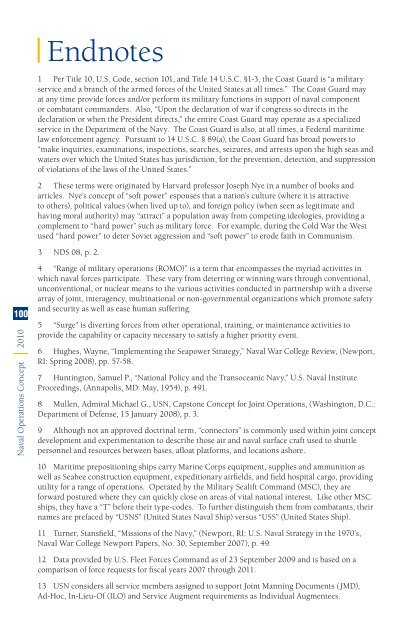Naval Operations Concept - Defense Technical Information Center
Naval Operations Concept - Defense Technical Information Center
Naval Operations Concept - Defense Technical Information Center
Create successful ePaper yourself
Turn your PDF publications into a flip-book with our unique Google optimized e-Paper software.
<strong>Naval</strong> <strong>Operations</strong> <strong>Concept</strong> 2010<br />
00<br />
Endnotes<br />
1 Per Title 10, U.S. Code, section 101, and Title 14 U.S.C. §1-3, the Coast Guard is “a military<br />
service and a branch of the armed forces of the United States at all times.” The Coast Guard may<br />
at any time provide forces and/or perform its military functions in support of naval component<br />
or combatant commanders. Also, “Upon the declaration of war if congress so directs in the<br />
declaration or when the President directs,” the entire Coast Guard may operate as a specialized<br />
service in the Department of the Navy. The Coast Guard is also, at all times, a Federal maritime<br />
law enforcement agency. Pursuant to 14 U.S.C. § 89(a), the Coast Guard has broad powers to<br />
“make inquiries, examinations, inspections, searches, seizures, and arrests upon the high seas and<br />
waters over which the United States has jurisdiction, for the prevention, detection, and suppression<br />
of violations of the laws of the United States.”<br />
2 These terms were originated by Harvard professor Joseph Nye in a number of books and<br />
articles. Nye’s concept of “soft power” espouses that a nation’s culture (where it is attractive<br />
to others), political values (when lived up to), and foreign policy (when seen as legitimate and<br />
having moral authority) may “attract” a population away from competing ideologies, providing a<br />
complement to “hard power” such as military force. For example, during the Cold War the West<br />
used “hard power” to deter Soviet aggression and “soft power” to erode faith in Communism.<br />
3 NDS 08, p. 2.<br />
4 “Range of military operations (ROMO)” is a term that encompasses the myriad activities in<br />
which naval forces participate. These vary from deterring or winning wars through conventional,<br />
unconventional, or nuclear means to the various activities conducted in partnership with a diverse<br />
array of joint, interagency, multinational or non-governmental organizations which promote safety<br />
and security as well as ease human suffering.<br />
5 “Surge” is diverting forces from other operational, training, or maintenance activities to<br />
provide the capability or capacity necessary to satisfy a higher priority event.<br />
6 Hughes, Wayne, “Implementing the Seapower Strategy,” <strong>Naval</strong> War College Review, (Newport,<br />
RI: Spring 2008), pp. 57-58.<br />
7 Huntington, Samuel P., “National Policy and the Transoceanic Navy,” U.S. <strong>Naval</strong> Institute<br />
Proceedings, (Annapolis, MD: May, 1954), p. 491.<br />
8 Mullen, Admiral Michael G., USN, Capstone <strong>Concept</strong> for Joint <strong>Operations</strong>, (Washington, D.C.:<br />
Department of <strong>Defense</strong>, 15 January 2008), p. 3.<br />
9 Although not an approved doctrinal term, “connectors” is commonly used within joint concept<br />
development and experimentation to describe those air and naval surface craft used to shuttle<br />
personnel and resources between bases, afloat platforms, and locations ashore.<br />
10 Maritime prepositioning ships carry Marine Corps equipment, supplies and ammunition as<br />
well as Seabee construction equipment, expeditionary airfields, and field hospital cargo, providing<br />
utility for a range of operations. Operated by the Military Sealift Command (MSC), they are<br />
forward postured where they can quickly close on areas of vital national interest. Like other MSC<br />
ships, they have a “T” before their type-codes. To further distinguish them from combatants, their<br />
names are prefaced by “USNS” (United States <strong>Naval</strong> Ship) versus “USS” (United States Ship).<br />
11 Turner, Stansfield, “Missions of the Navy,” (Newport, RI: U.S. <strong>Naval</strong> Strategy in the 1970’s,<br />
<strong>Naval</strong> War College Newport Papers, No. 30, September 2007), p. 49.<br />
12 Data provided by U.S. Fleet Forces Command as of 23 September 2009 and is based on a<br />
comparison of force requests for fiscal years 2007 through 2011.<br />
13 USN considers all service members assigned to support Joint Manning Documents (JMD),<br />
Ad-Hoc, In-Lieu-Of (ILO) and Service Augment requirements as Individual Augmentees.

















